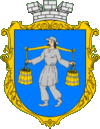Boryslaw
| Boryslaw | ||
| Борислав | ||

|
|
|
| Basic data | ||
|---|---|---|
| Oblast : | Lviv Oblast | |
| Rajon : | District-free city | |
| Height : | no information | |
| Area : | 37.00 km² | |
| Residents : | 38,442 (2004) | |
| Population density : | 1,039 inhabitants per km² | |
| Postcodes : | 82390 | |
| Area code : | +380 3248 | |
| Geographic location : | 49 ° 17 ' N , 23 ° 25' E | |
| KOATUU : | 4610300000 | |
| Administrative structure : | 1 city , 1 urban-type settlement | |
| Mayor : | Oleh Ivanyzkyj | |
| Address: | вул. Шевченка 42 82300 м. Борислав |
|
| Website : | місто Борислав (Ukrainian) | |
| Statistical information | ||
|
|
||
Boryslaw ( Ukrainian Борислав ; Russian Борислав Borislaw , Polish Borysław , German also Borislau ) is a Ukrainian city with a little over 38,000 inhabitants. It is located in the Lviv Oblast and is located south of the Oblast capital Lviv . The next largest city is Drohobych .
The city nor the southwest location belongs urban-type settlement Skhidnytsia . 1930, the previously independent villages Bania Kotowska (Ukrainian Баня Котівська Banja Kotiwska ) Hubicze (Ukrainian Губичі Hubytschi ) Mraznica (Ukrainian Мразниця Mrasnyzja ) and Tustanowice (Ukrainian Тустановичі Tustanowytschi incorporated).
oil
In the second half of the 19th century, Boryslaw became widely known as one of the most important centers of oil production in the world at that time . The foothills of the Carpathian Mountains have numerous places where oil deposits reach close to the surface of the earth. Commercial oil production from hand-dug septic tanks has been handed down since the 16th century. Naphtha or ground naphtha, as the seepage oil was called at the time, found its way into large parts of Europe as a lubricant and medicine.
This raw material base motivated the pharmacist Ignacy Łukasiewicz to develop a kerosene lamp in 1853 . In search of sources of supply for the necessary fuel, the first oil mine was built in Bóbrka south of Krosno in 1854 . This triggered an oil boom in various places in the Carpathian region, as a result of which, for example, around 4,000 manually dug shafts for the extraction of oil and mineral wax ( ozokerite ) were built in and around Boryslaw between 1860 and 1865 . From 1861 the oil could be transported by rail to Vienna, where it was mainly processed into kerosene and lubricants in a refinery built in 1860.
As the depth of the developed deposits increased, deep drilling technology replaced the previous shaft construction around 1865 . Wells were soon being drilled to depths of 1,500 m. Oil production in Galicia peaked at almost 3 million tons in 1912. Most of them came from the Boryslaw region. However, due to the excessive exploitation of the deposits before the First World War , the pre-war production figures could never be reached again later. In the war in 1914/15 the conveyor systems were badly damaged. Even today there is still a small amount of oil produced in the urban area of Boryslaw.
Personalities
- Sabina Wolanski (1927–2011), Jewish survivor of the Holocaust
- Berthold Beitz (1913–2013), commercial manager of factories in Boryslaw during the German occupation of the Ukraine from 1941 to 1944. He saved hundreds of local Jews from the Holocaust
- Emil Müller , pseudonym also: E. Sturmheim (1886–1952), writer, anti-fascist, political activist for Austria
- Józef Lipman (1931), emeritus professor of petrochemistry, Jewish survivor of the Holocaust
- Mignon Langnas (1903–1949), nurse in the Jewish children's hospital in Vienna, survivor of the Holocaust.
Web links
- 145 original documents about the extermination of Jews in Boryslaw by the Germans (approx. 15,000 victims) in the Simon Wiesenthal Center LA
- Jérôme SEGAL: Black gold and yellow star - forms of mobility for Galician Jews who invested in the oil industry , in: DAVID - Jüdische Kulturzeitschrift, issue 84 (2010) Article about oil and mineral wax production in Boryslaw
- Memories of the Polish-Jewish professor Józef Lipman about his childhood lost in the Holocaust



